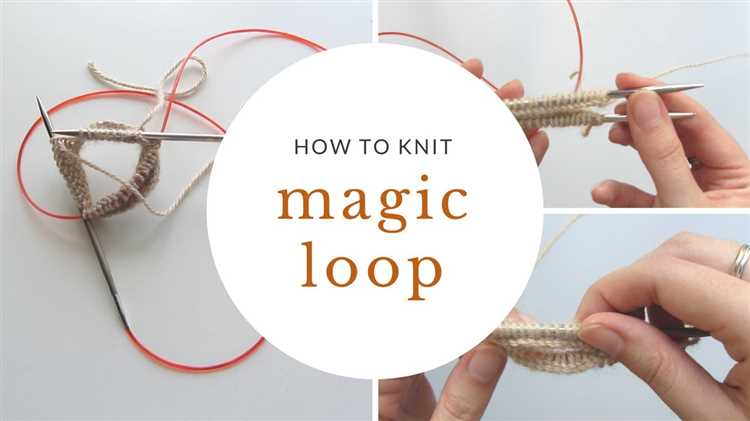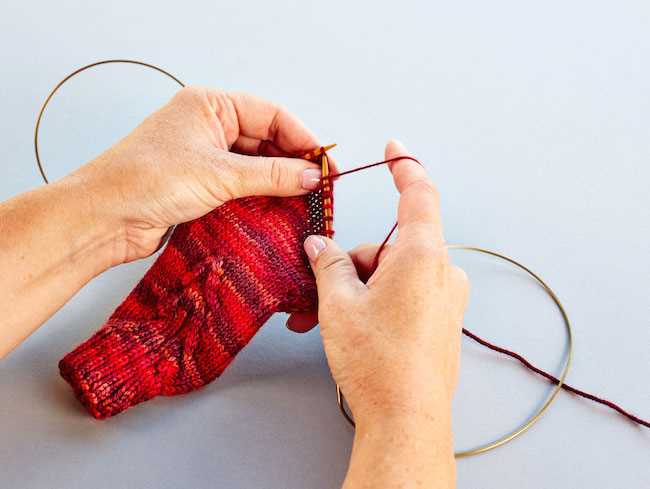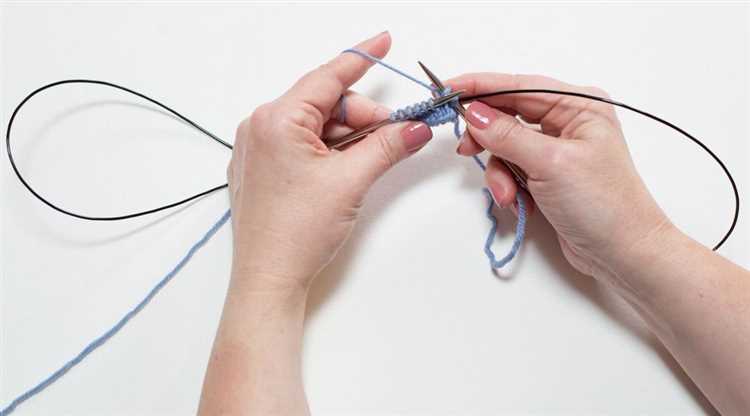If you’re a knitting enthusiast, you’ve probably heard of the magic loop technique. This popular knitting method allows you to knit projects with a small circumference, such as socks or sleeves, using a long circular needle. Magic loop knitting is a great alternative to using double-pointed needles, as it eliminates the need for switching needles and allows for seamless knitting.
The magic loop technique was developed by Sarah Hauschka in the early 2000s. It involves using a circular needle with a long cable, typically at least 32 inches in length. The cable is divided into two sections, with one loop of the cable holding the active stitches while the other loop is used to work the stitches. By manipulating the loops, you can easily move the stitches along the cable and work on a small circumference.
One of the advantages of magic loop knitting is its versatility. This technique can be used for a variety of knitting projects, including hats, mittens, and even larger garments like sweaters. It’s a great option for knitters who prefer to work with circular needles and want to avoid the bulkiness of double-pointed needles. Magic loop knitting is also ideal for knitters who are new to knitting in the round, as it provides a more controlled and manageable knitting process.
Although magic loop knitting may seem intimidating at first, it’s relatively easy to learn with a bit of practice. There are many tutorials and resources available online that can guide you through the process, and once you get the hang of it, you’ll find that it’s a valuable technique to add to your knitting toolbox. So, if you’re looking to expand your knitting skills and tackle projects with small circumferences, give magic loop knitting a try!
What is Magic Loop Knitting?
Magic Loop knitting is a technique used to knit small-circumference projects, such as socks, hats, and sleeves, using a long circular needle. This technique allows you to avoid using double-pointed needles and provides a seamless and continuous knitting experience.
The magic loop method involves using a circular needle that is at least 32 inches long, although longer needles are often preferred. The cable of the needle is looped in the middle, creating two needle tips on each end. This loop acts as a pivot point, allowing you to knit both sides of the project using a single long needle.
To start knitting with the magic loop method, you cast on your stitches and divide them evenly onto the two needle tips. You then pull the cable between the stitches, creating a loop in the middle. This loop is where the “magic” happens and allows you to work one side of the stitches while the other side is held on the loop.
When knitting in the round with magic loop, you will typically work half of the stitches first, using the needle tip that is closest to you. After completing these stitches, you will slide the stitches on the cable to the other end of the needle and work the remaining stitches. This process is repeated until you have completed all of the rounds needed for your project.
Magic loop knitting is popular among knitters because it eliminates the need for multiple sets of double-pointed needles and reduces the risk of losing stitches. It is also a versatile technique that can be used for projects of various sizes and allows for easy adjustments to accommodate different stitch counts.
If you are new to magic loop knitting, it may take some practice to feel comfortable with the technique. However, once you master it, magic loop knitting can become a valuable skill in your knitting toolbox, allowing you to tackle a wider range of projects with ease!
Benefits of Magic Loop Knitting
Magic loop knitting is a technique that allows knitters to work with a small number of stitches on a long circular needle. This method offers several advantages over traditional knitting with double-pointed needles.
- No need for multiple needles: With magic loop knitting, you only need one long circular needle, eliminating the need for multiple double-pointed needles. This makes the technique more accessible and less confusing for beginners.
- Great for small circumferences: Magic loop knitting is particularly useful for working on small projects with a small number of stitches, such as socks, sleeves, and gloves. The long circular needle allows for easy manipulation of the stitches without the risk of them falling off.
- No ladders: When using double-pointed needles, it’s easy to create ladders or gaps between the stitches where the needles meet. Magic loop knitting eliminates this issue, resulting in more even tension and a neater finished product.
- Less chance of losing stitches: With traditional knitting on double-pointed needles, there is always a risk of accidentally dropping or losing stitches. Magic loop knitting reduces this risk since all the stitches are held securely on the circular needle throughout the entire project.
- Flexible cable length: The length of the circular needle used for magic loop knitting can be adjusted to accommodate different project sizes. This flexibility allows for greater versatility and convenience when working on various knitting projects.
Overall, magic loop knitting offers knitters a convenient and efficient way to work on small projects without the need for multiple double-pointed needles. It provides greater control and stability, resulting in neater stitches and a more enjoyable knitting experience.
Tools and Materials for Magic Loop Knitting
To get started with magic loop knitting, you’ll need a few essential tools and materials. Here is a list of what you’ll need:
- Circular needles: You’ll need a pair of circular knitting needles with a long flexible cable. The length of the cable will depend on the size of your project, but a cable length of at least 32 inches is recommended for most projects.
- Yarn: Choose a yarn that is suitable for your project. The weight and fiber content will depend on the pattern you’re working on. Make sure to check the recommended yarn weight and gauge in the pattern instructions.
- Stitch markers: These are essential for marking the beginning of your rounds and any important stitch placements in the pattern. You can use simple plastic rings or buy special stitch markers designed for knitting.
- Tapestry needle: You’ll need a tapestry needle for weaving in ends and finishing your project. Choose a needle with a large eye that can accommodate the yarn thickness.
- Scissors: A pair of scissors or yarn snips will come in handy for cutting your yarn.
- Row counter: While not strictly necessary, a row counter can be helpful for keeping track of your progress, especially if you’re working on a complex pattern.
- Blocking materials: Depending on the type of project you’re working on, you may need blocking mats, pins, and a spray bottle for blocking and shaping your finished piece.
Optional Tools
In addition to the essential tools mentioned above, there are a few optional tools you may find useful:
- Cable needle: If you’re working on a pattern that involves cabling, you may want to have a cable needle on hand. This tool helps you hold stitches to create the cable twists.
- Darning needle: A darning needle can be useful for repairing any dropped stitches or fixing mistakes in your knitting.
- Stitch holders: If you need to put stitches on hold for any reason, stitch holders can come in handy. They come in various shapes and sizes to accommodate different types of stitches.
With these tools and materials, you’ll be well-equipped to start your magic loop knitting adventure. Happy knitting!
Getting Started with Magic Loop Knitting
Magic loop knitting is a technique that allows you to knit small circumference projects, such as socks or hats, using a long circular needle instead of double-pointed needles. It’s a great alternative if you find knitting with double-pointed needles fiddly or uncomfortable.
To get started with magic loop knitting, you’ll need:
- A long circular needle with a flexible cable. A needle length of 32 inches or longer is recommended.
- A ball of yarn appropriate for your project.
- A set of stitch markers to help you keep track of your stitches.
Once you have your supplies ready, follow these steps to begin magic loop knitting:
- Cast on the required number of stitches for your project. Make sure to leave a long tail, as you’ll need it for the magic loop.
- Locate the midpoint of your cast-on stitches and slide the stitches to the center of the circular needle cable.
- Bend the needle cable in half so that the midpoint of your stitches is at the bend.
- Hold the needle with the stitches in your right hand and the working yarn in your left hand.
- Thread the left needle tip through the stitches at the left side of the cable, starting with the first stitch.
- Gently pull the cable through the stitches, allowing them to slide onto the needle. You now have half of your stitches on one needle and the other half on the cable.
- Rotate your work so that the needle with the stitches is in your left hand and the cable is in your right hand.
- Repeat steps 5-7 for the remaining stitches. You should now have all of your stitches on one needle and the cable.
You are now ready to begin knitting in the round using the magic loop technique. Simply knit or purl across the stitches on the needle, ignoring the stitches on the cable. When you reach the end of the needle, rotate your work and continue knitting or purling.
As you progress with your project, make sure to adjust the tension on the cable to prevent the stitches from becoming too tight or loose. Also, remember to place stitch markers to mark any pattern repeats or increases/decreases in your project.
With a little practice, magic loop knitting can become a favorite technique for knitting small circumference projects. It offers convenience, comfort, and versatility, allowing you to tackle a wide range of knitting projects with ease.
Tips and Techniques for Magic Loop Knitting
Magic Loop knitting is a versatile technique that allows you to knit small circumference projects, such as socks or sleeves, using a long circular needle. Here are some tips and techniques to make your magic loop knitting experience more enjoyable:
1. Use the Right Needle Size
When using the magic loop technique, it’s important to use the right needle size to achieve the desired gauge. Make sure to check the recommended needle size for your project and choose a circular needle that matches it.
2. Divide Stitches Evenly
When dividing your stitches for magic loop, it’s important to distribute them evenly on both needle tips. This will help maintain tension and ensure that your stitches are not too tight or too loose.
3. Mark Your Rounds
Keeping track of your rounds is important, especially when knitting in the round. Use stitch markers to mark the beginning of each round, making it easier to keep track of your progress and avoid mistakes.
4. Use a Smooth Yarn
Smooth yarns, such as bamboo or cotton, work best for magic loop knitting. They slide easily on the needles, making it easier to manipulate the stitches and maintain an even tension.
5. Practice Tension Control
Tension control is crucial when knitting in the round, especially with the magic loop technique. Practice maintaining an even tension by making sure your stitches are neither too tight nor too loose.
6. Avoid Ladders
Ladders can occur when working with the magic loop technique, especially if there is a significant difference in tension between the two needle tips. To avoid ladders, make sure to snug up the first stitch of each needle tip to reduce any gaps.
7. Take Breaks
Knitting with the magic loop technique can be more time-consuming than traditional knitting methods. Take breaks and stretch your hands and fingers to avoid fatigue and strain.
8. Experiment with Different Projects
Once you’ve mastered the basics of magic loop knitting, don’t be afraid to experiment with different projects. Try knitting hats, mittens, or even sweaters using the magic loop technique to expand your knitting skills.
In conclusion, magic loop knitting is a useful technique for knitting small circumference projects. By following these tips and techniques, you can enhance your magic loop knitting skills and create beautiful, seamless projects.
Common Mistakes to Avoid in Magic Loop Knitting
While magic loop knitting can be a great technique for knitting small circumference projects like socks and sleeves, there are a few common mistakes that beginners often make. By being aware of these mistakes, you can save time and frustration in your knitting journey.
- Twisting the stitches: One of the most common mistakes in magic loop knitting is twisting the stitches when transferring them from one needle to the other. Make sure to double-check that your stitches are oriented correctly on your needles before you start knitting.
- Using the wrong needle size: Using the wrong needle size can lead to uneven tension and gauge issues in your knitting. It’s important to check the recommended needle size for your project and use a needle that gives you the correct gauge.
- Not understanding the concept of “live” and “inactive” stitches: In magic loop knitting, you will have “live” stitches on one needle and “inactive” stitches on the other. It’s important to keep track of which stitches you are knitting and which ones are being held. Mixing up live and inactive stitches can lead to dropped or twisted stitches.
- Tugging too hard on the yarn: Tugging too hard on the yarn can cause your stitches to become tight and difficult to work with. It’s important to maintain an even tension as you knit to ensure that your stitches are uniform and easy to manipulate.
- Not using stitch markers: Stitch markers can be a helpful tool in magic loop knitting to keep track of your rounds and decreases. Not using stitch markers can make it difficult to stay organized and can lead to mistakes in your knitting.
By avoiding these common mistakes, you can enhance your magic loop knitting skills and achieve beautiful, professional-looking results in your projects.
Projects and Patterns for Magic Loop Knitting
With the magic loop knitting technique, you can create a variety of projects, from socks and mittens to sweaters and shawls. This versatile method allows you to knit in the round with a long circular needle, eliminating the need for double-pointed needles. Here are a few project ideas and patterns to get you started:
- Socks: Magic loop knitting is perfect for knitting socks. You can find many patterns specifically designed for this technique, allowing you to create beautiful socks with intricate stitch patterns and unique designs.
- Mittens and Gloves: Similarly to socks, magic loop knitting can be used to knit mittens and gloves. You can customize the patterns to fit your hand size and create snug and cozy accessories for the winter season.
- Hats: You can knit hats using the magic loop technique, adjusting the needle size and stitch count to achieve the desired size and fit. This allows you to create hats for people of all ages, from newborns to adults.
- Sweaters: Magic loop knitting can also be used to knit seamless sweaters in the round. This technique allows you to knit the body and sleeves without any seams, resulting in a clean and polished finished garment.
- Shawls: Shawls can be knitted using the magic loop technique to create beautiful lace or textured designs. The long circular needle makes it easy to work on larger projects with multiple stitches, allowing for intricate and detailed shawl patterns.
When using the magic loop knitting technique, it’s important to choose patterns that are specifically designed for this method. These patterns will provide instructions on how to adapt the pattern and stitches to work with a long circular needle. Additionally, you can also modify existing patterns by adjusting the stitch count and needle size to fit the magic loop technique.
Whether you’re a beginner or an experienced knitter, magic loop knitting opens up a world of possibilities for your knitting projects. With a little practice, you’ll soon be able to knit in the round with ease and create beautiful and seamless garments and accessories.
FAQ:
What is the magic loop knitting technique?
Magic loop knitting is a technique used to knit small circumference projects, such as socks or sleeves, using a long circular needle. It involves sliding stitches onto the cable of the circular needle and using the needle tips to work the stitches. This eliminates the need for double-pointed needles or multiple circular needles.
Why would I use magic loop knitting instead of double-pointed needles?
Magic loop knitting can be more convenient and easier to manage than using double-pointed needles. With magic loop, you only need one long circular needle, whereas with double-pointed needles you would need multiple needles. Magic loop also eliminates the risk of dropping or losing stitches.
What kind of projects can I use magic loop knitting for?
Magic loop knitting can be used for any project that requires knitting a small circumference in the round, such as socks, sleeves, hats, or mittens. It can also be used for larger projects by dividing the stitches onto two or more cables and working them one section at a time.
Is magic loop knitting difficult to learn?
While magic loop knitting may take a bit of practice to get the hang of, it is not inherently difficult to learn. Once you understand the basic technique and get comfortable with manipulating the needles and stitches, it becomes a straightforward method for knitting in the round.


